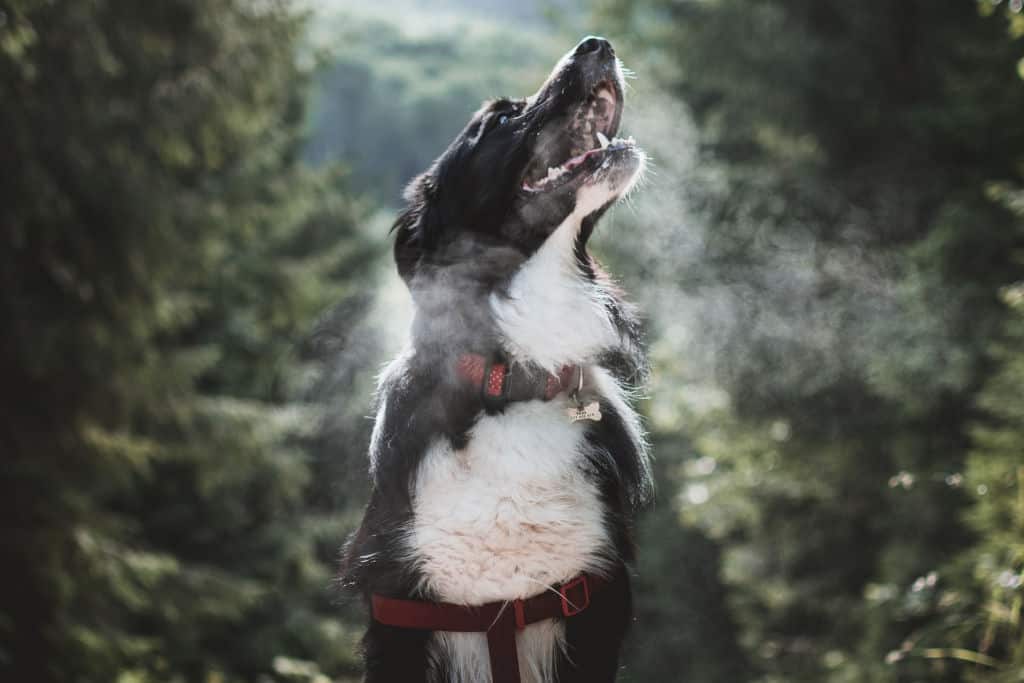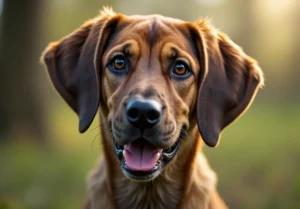Disclosure: We may earn a commission from helpful, relevant links in our content. No cost to you. See our privacy policy.
My dog breathes strangely sometimes, and I get worried about whether this is normal. Can dogs easily breathe if they don’t open their mouths?
Dive deeper to understand the intricacies of canine breathing and factors that influence it.

Do Dogs Breathe Through Their Nose or Mouth?
Dogs can breathe through their nose or mouth. They might breathe through their mouth to get more air if they’re doing something hard. If dogs are calm and at ease, they will use their nose.
Canines control heat exchange in their bodies primarily through their mouths and foot pads. They do not sweat like humans.
When you see a dog panting, it’s more than just breathing. They attempt to remove excess heat, especially after strenuous exercise or on a hot day.
To regulate their body temperature, dogs pant or breathe with their mouth open. Because dogs do not sweat, they control their body temperature through this activity and the pads of their feet.
It’s normal to notice panting after being outside on a hot day, and they will breathe with open mouths to cool off. I would, however, keep an eye out for excessive panting and anything that’s out of proportion to the dog’s current or previous environment and lasts for an extended time.
In these cases, the dog may have difficulty breathing due to a medical condition you were unaware of. If you notice your dog panting excessively, I recommend taking them to the vet to ensure there isn’t a health problem developing.
What Makes My Dog Breathe Only Through His Mouth?
Dogs prefer to breathe through their noses. Mouth breathing can cause coughing and swallowing difficulties. However, dogs breathe through their mouth rather than their nose when they pant.
Dogs’ old age can cause mouth breathing as well. My old retriever has these issues when the temperature rises above 15 degrees. She is perfectly fine in the cold.
When dogs are warm, as well as when they are running, digging, or playing, they breathe through their mouths. I saw a nearly dead mouse open its mouth to gasp for air. So I’m inclined to believe, but not certain, that most mammals can do this.
Dogs might also resort to mouth-breathing due to other reasons beyond the obvious ones. Some of these factors include anxiety, dental issues, certain medications, or even responses to specific scents. Being vigilant and noticing any abnormal patterns in your dog’s breathing can help in early diagnosis of potential health concerns
Unless the problem is in the windpipe or lungs, your dog will breathe through their mouth if they can’t get enough air through the nose. However, this can also be caused by an illness. You may consider taking your dog to the vet to find out if they are healthy.
If your dog only breathes through his mouth, he may have a respiratory problem. Respiratory distress is a serious business. There are numerous reasons why a dog cannot live through the nose.
There could be allergies or something lodged in the nostril, but it could also be a growth (cyst, tumor, etc.) If there is a problem with the trachea (windpipe), it will be unable to breathe correctly through the mouth or nose.
How Can You Tell if a Dog Is Having Trouble Breathing?
When at rest, a healthy pet should take between 15 and 35 breaths per minute and more during exercise. Any breathing rate greater than 40 breaths per minute when your dog is resting is considered abnormal and should be investigated.
To find the perfect routine for your dog, check our guide on dog exercise routines based on breed, size and age.
When an animal has difficulty breathing, the owner’s first response should be to call the veterinarian. Talk to your veterinarian about quality of life and how to tell when your dogs are having difficulty breathing.
Tiredness, shallow breathing, and a loss of appetite? These are emergency warning signs.
A dog’s breathing may become difficult due to heart failure or fluid in the chest cavity. If your dog begins to exhibit this behavior, take it to the vet right away for X-rays to determine if there is a blockage or illness.
You can also examine their gums. Are they the same healthy pink as yours? Or are their gums a lighter pink color? You’re in trouble if they’re pale pink. It would be best to go to the vet because the blood lacks oxygen.
If your dog is having trouble breathing or losing appetite, you should take them to the vet immediately. This could be a sign of a variety of diseases, including cancer. There are numerous examples of this, so our first reaction should be to take your pet to the vet.
What to Do if Your Dog Is Breathing Fast?
Dogs sweat by moving air in and out, so while they may appear out of breath, they may be hot. It’s still best to get the dog to the vet for an exam.
Is he slower when he’s sleeping? If so, it could be anxiety from being in a new place and with a new person. Rapid and heavy breathing could signify stress, especially if the dog is rescued. The dog may require more space and rest.
If it’s a rescue dog, maintain white noise in the house and get him a cooling pad. Continue to use those effective techniques to calm him. It sounds like anxiety, most likely due to a combination of stressors.
FAQ
Can dogs breathe through their mouth even if their nose isn’t blocked?
Yes, dogs can breathe through their mouth even without a nasal blockage, often doing so to regulate body temperature, during physical exertion, or due to certain medical conditions.
Why shouldn’t you tap a dog on the nose?
Your dog may not appear aggressive or fearful, but repeated head taps will result in a fearful dog. A head-shy dog is afraid of meeting new people because people always go for the head, and it creates problems when you need to apply ear drops, eye drops, or anything with the dog’s head.
How far can a dog smell?
According to studies, dogs can detect scents up to 15 to 20 miles away. Their sense of smell is approximately 10,000 times stronger than humans, and they can detect odors in parts per trillion. You can get this great book called “Inside of a Dog,” which explains everything.
Who has a more powerful nose, a cat or a dog?
According to The Baltimore Sun, a cat’s nose contains 50 million to 80 million odor-sensitive olfactory receptor cells. In contrast, a dog’s nose has 200 million to 300 million (depending on breed, with the bloodhound topping the list). Therefore, a dog has a more powerful nose.
Alex, a passionate animal lover, has experience in training and understanding animal behavior. As a proud pet parent to two dogs and three cats, he founded AnimalReport.net to share insights from animal experts and expand his knowledge of the animal kingdom.




